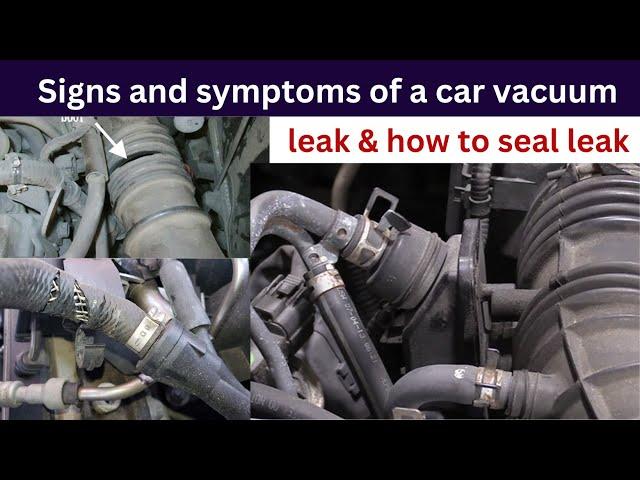
Signs and symptoms of a car vacuum leak & how to seal leak
Signs and Symptoms Of A car Vacuum leak, Causes and How to fix the Leaks
A vacuum leak can cause several drivability problems, as it will bring more air into the engine and reduce its air/fuel mixture. An internal combustion engine uses an Intake vacuum to control actuators, sensors, and power brakes. In older vehicles, it is used to operate specific emission control systems and draw fuel into the engine. Even a tiny vacuum leak can cause your vehicle's computer to think you need to repair a particular sensor or component.
You then begin to replace parts in a vain attempt to resolve the problem. A vacuum leak usually emits a hissing sound, making it easier to find. However, sometimes you will not hear anything. To locate leaks that are difficult to find, auto shops use expensive and specialized technology. You can use simple procedures to discover the most common vacuum leaks before you visit the shop. This video will help you understand vacuum leak symptoms and identify possible signs of vacuum leaks and other details.
Please support me by clicking the like button and subscribing to my channel so that you are notified whenever I upload new videos. So let's begin!
What is an engine vacuum leak?
To begin, let us define a vacuum leak. A vacuum leak is a situation where the system leaks. It usually occurs with the relay pipes. Typically, it occurs between the mass airflow sensor (MAF) and the engine. Vacuum leaks can create imbalances, affecting airflow and the fuel/air mixture. Modern cars alert you to the possibility of a defective vacuum system through sensors. When there is a leak in your engine's intake manifold, air can enter without going through the throttle body.
The ECU will inject the correct amount of fuel based on airflow detected by the ECU. The air/fuel mix is crucial to how your vehicle travels and uses its fuel. You may notice many symptoms that indicate an unbalanced mixture of air and fuel. This ratio can reach 14.7:1. This ratio represents a lean mixture that no owner of a car wants to have in their vehicle because it makes for a bad drive. Let's look at some more signs and symptoms of vacuum leaks.
Symptoms and Signs of Vacuum Leak
List performance problems to be aware of, as a leak could cause them. Remember that these symptoms and signs are not exclusive to a vacuum leak. One or more of these symptoms can be caused by a faulty EGR Valve, ignition timing problems, or insufficient compression.
1. Reduced fuel economy; You might notice a fuel injection vacuum leak manifesting itself through reduced fuel efficiency. The fuel does not burn well when there is an imbalance in the air/fuel ratio. This problem occurs primarily because of too much intake of air. A malfunctioning vacuum and tubes can lead to poor fuel usage, which could increase consumption. Problems arise from a delay in the release of exhaust gases. The gas buildup also results in an inefficient combustion of fuel.
2. Rough idle; during idling, your car engine is more susceptible to malfunctions. Unsurprisingly, rough idle is one of the most severe vacuum leak indicators. The throttle body tries to maintain an even idle speed by opening/closing the throttle valve. Your throttle body will have difficulty controlling a vacuum leak that is large enough to cause unusual idling. A vacuum leak could be causing the air/fuel mixture to become inadequate.
3. Excessive RPM at Idle; while idle, vacuum pressure is present inside the intake manifold because the throttle body stops your engine from revving faster. More air is allowed into the engine when you have a vacuum leak in your car engine. It causes it to rev up. In most cases, an increased engine idle RPM can signal a leak.
4. Unusual smoke; Exhaust gasses from an automobile can often indicate a problem. You may detect unique white or black smoke. The latter is more common when incomplete combustion causes vacuum leaks due to an air/fuel imbalance. The result is an accumulation of black exhaust gases.
5. Rough/Delayed Accumulation; A vacuum loss usually causes jerky acceleration because the engine receives the wrong air/fuel mixture due to the unquantified air entering or leaving the vehicle engine. A vacuum leak usually results in a lean mixture and delayed acceleration. The vehicle engine will try to accelerate but is being held back. Many other factors can contribute to poor acceleration. Always conduct a thorough diagnostic before replacing any component.
6. Backfires and Misfires. Whenever a vacuum leaks in your engine, you will often experience misfires or backfires. Sometimes the air/fuel ratio can become so lean it cannot ignite the cylinders. This can result in misfire error codes such as P0300. If your engine misfires just once, the cause is usually a leak in the intake gasket. If you experience misfires in all cylinders of your vehicle, it could be due to a leak near t
Please don’t forget to like, leave a comment, subscribe to my channel for more useful videos. Thanks
A vacuum leak can cause several drivability problems, as it will bring more air into the engine and reduce its air/fuel mixture. An internal combustion engine uses an Intake vacuum to control actuators, sensors, and power brakes. In older vehicles, it is used to operate specific emission control systems and draw fuel into the engine. Even a tiny vacuum leak can cause your vehicle's computer to think you need to repair a particular sensor or component.
You then begin to replace parts in a vain attempt to resolve the problem. A vacuum leak usually emits a hissing sound, making it easier to find. However, sometimes you will not hear anything. To locate leaks that are difficult to find, auto shops use expensive and specialized technology. You can use simple procedures to discover the most common vacuum leaks before you visit the shop. This video will help you understand vacuum leak symptoms and identify possible signs of vacuum leaks and other details.
Please support me by clicking the like button and subscribing to my channel so that you are notified whenever I upload new videos. So let's begin!
What is an engine vacuum leak?
To begin, let us define a vacuum leak. A vacuum leak is a situation where the system leaks. It usually occurs with the relay pipes. Typically, it occurs between the mass airflow sensor (MAF) and the engine. Vacuum leaks can create imbalances, affecting airflow and the fuel/air mixture. Modern cars alert you to the possibility of a defective vacuum system through sensors. When there is a leak in your engine's intake manifold, air can enter without going through the throttle body.
The ECU will inject the correct amount of fuel based on airflow detected by the ECU. The air/fuel mix is crucial to how your vehicle travels and uses its fuel. You may notice many symptoms that indicate an unbalanced mixture of air and fuel. This ratio can reach 14.7:1. This ratio represents a lean mixture that no owner of a car wants to have in their vehicle because it makes for a bad drive. Let's look at some more signs and symptoms of vacuum leaks.
Symptoms and Signs of Vacuum Leak
List performance problems to be aware of, as a leak could cause them. Remember that these symptoms and signs are not exclusive to a vacuum leak. One or more of these symptoms can be caused by a faulty EGR Valve, ignition timing problems, or insufficient compression.
1. Reduced fuel economy; You might notice a fuel injection vacuum leak manifesting itself through reduced fuel efficiency. The fuel does not burn well when there is an imbalance in the air/fuel ratio. This problem occurs primarily because of too much intake of air. A malfunctioning vacuum and tubes can lead to poor fuel usage, which could increase consumption. Problems arise from a delay in the release of exhaust gases. The gas buildup also results in an inefficient combustion of fuel.
2. Rough idle; during idling, your car engine is more susceptible to malfunctions. Unsurprisingly, rough idle is one of the most severe vacuum leak indicators. The throttle body tries to maintain an even idle speed by opening/closing the throttle valve. Your throttle body will have difficulty controlling a vacuum leak that is large enough to cause unusual idling. A vacuum leak could be causing the air/fuel mixture to become inadequate.
3. Excessive RPM at Idle; while idle, vacuum pressure is present inside the intake manifold because the throttle body stops your engine from revving faster. More air is allowed into the engine when you have a vacuum leak in your car engine. It causes it to rev up. In most cases, an increased engine idle RPM can signal a leak.
4. Unusual smoke; Exhaust gasses from an automobile can often indicate a problem. You may detect unique white or black smoke. The latter is more common when incomplete combustion causes vacuum leaks due to an air/fuel imbalance. The result is an accumulation of black exhaust gases.
5. Rough/Delayed Accumulation; A vacuum loss usually causes jerky acceleration because the engine receives the wrong air/fuel mixture due to the unquantified air entering or leaving the vehicle engine. A vacuum leak usually results in a lean mixture and delayed acceleration. The vehicle engine will try to accelerate but is being held back. Many other factors can contribute to poor acceleration. Always conduct a thorough diagnostic before replacing any component.
6. Backfires and Misfires. Whenever a vacuum leaks in your engine, you will often experience misfires or backfires. Sometimes the air/fuel ratio can become so lean it cannot ignite the cylinders. This can result in misfire error codes such as P0300. If your engine misfires just once, the cause is usually a leak in the intake gasket. If you experience misfires in all cylinders of your vehicle, it could be due to a leak near t
Please don’t forget to like, leave a comment, subscribe to my channel for more useful videos. Thanks
Тэги:
#vacuum_leaks #signs_and_symptoms_of_vacuum_leaks #causes_of_vacuum_leaks #How_to_seal_vacuum_leaks #signs_and_symptoms_of_a_car_vacuum_leak_and_how_to_seal_leak #intake_manifold_vacuum_leak_quick_fix #fuel_injector_vacuum_leak_symptoms #vacuum_leak_repair_cost #brake_vacuum_hose_leak_symptoms #how_long_can_you_drive_with_a_vacuum_leak #driving_with_a_vacuum_leak #vacuum_leak_sound_when_accelerating #intake_manifold_vacuum_leak_repair_cost #car #car_vacuumКомментарии:
"How to Make Your Ideas Unforgettable: Insights from 'Made to Stick'"
Money Mindset Mastery
Dożynki Powiatu Kępińskiego 2021
radiosud.pl
Made to Stick: Why Some Ideas Survive and Others Die
Essens Book Summaries
سمبوسك بعدة حشوات1- منال العالم
Manal Alalem
Star Wars Outlaws - Jet Kordos Vermächtnis - Holodiscs und Tresorräume Komplettlösung
Wooco - Lösungen, Trailer und Tipps
Professionelles Ziehwerkzeug (HX-01)
A-Key GmbH Großhandel für Schlüsseldienste











